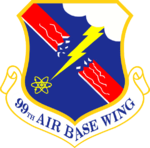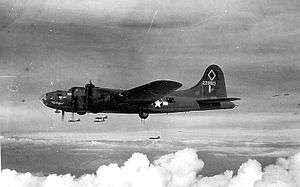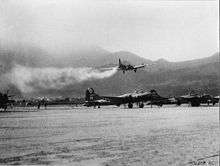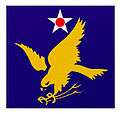99th Air Base Wing
| 99th Air Base Wing | |
|---|---|
|
F-35A Lighting II at Nellis AFB, Nevada for Operational Testing | |
| Active | 28 January 1942 |
| Country |
|
| Branch |
|
| Type | Air Base command |
| Part of | Air Combat Command |
| Garrison/HQ | Nellis Air Force Base |
| Engagements |
|
| Decorations |
|
| Commanders | |
| Current commander | Col. Richard H. Boutwell[1] |
| Notable commanders |
Richard C. Sanders Robert C. Hinson |
| Insignia | |
| Emblem of the 99th Air Base Wing |
 |
The 99th Air Base Wing (99 ABW) is a United States Air Force unit assigned to the Air Combat Command (ACC) and its ACC subordinate organization, the United States Air Force Warfare Center. It is based at Nellis Air Force Base, Nevada and also serves as the host wing at Nellis.
A non-flying wing, the organization oversees the daily base operations and mission support functions of Nellis AFB such as personnel, finance, civil engineering, security and supply.
The 99 ABW is the successor organization to the World War II 99th Bombardment Group. The group moved to Algeria in May 1943, where the group and its B-17 Flying Fortress aircraft distinguished themselves while flying bombing missions against targets in Italy, Sardinia and Sicily. Then, in December 1943, aircrews moved to Italy and conducted missions throughout Europe. Active for over 60 years, the 99th Strategic Reconnaissance Wing was part of Strategic Air Command's deterrent force during the Cold War, as a strategic reconnaissance wing.
The 99th Air Base Wing is commanded by Colonel Richard H. Boutwell. Its Command Chief Master Sergeant is Chief Master Sergeant Steven J. Cleveland.
Components
Three groups are assigned to the 99th: 99th Medical Group, 99th Mission Support Group and 99th Security Forces Group.
- 99th Medical Group – Provides medical care for the military community to ensure maximum wartime readiness and combat capability. The group's functions include flight medicine, surgical services, maternal and childcare, pharmacy, laboratory, radiology, dental care, medical benefits and information and diagnostic and therapeutic services.
- 99th Medical Support Squadron
- 99th Aerospace Medical Squadron
- 99th Medical Operations Squadron
- 99th Dental Squadron
- 99th Mission Support Group – Provides civil engineer, communications, contracting, logistics readiness, personnel and services support for Nellis and Creech AFB
- 99th Civil Engineer Squadron – Provides maintenance, repair, design and construction support for facilities and infrastructure, fire protection and crash rescue, disaster preparedness, military family housing, environmental compliance and explosive ordnance disposal.
- 99th Communications Squadron – Programs, operates and maintains the base computer networks and telecommunications systems.
- Operations Flight
- Plans and Programs Flight
- 99th Contracting Squadron – Executes the base central acquisition and contract performance management program.
- 99th Logistics Readiness Squadron – Provides motor vehicle operations and maintenance, traffic management and supply orders.
- Material Management Flight
- Readiness Flight
- Management and Systems Flight
- Traffic Management Flight
- Vehicle Management Flight
- Fuels Management Flight
- 99th Force Support Squadron – Includes military and civilian personnel, education services, enlisted professional education and family support. The squadron also provides services for lodging, food services, club management, laundry, mortuary affairs, base honor guard, base library and recreational activities.
- Military Personnel Flight
- Civilian Personnel Flight
- Educational Services Flight
- Airmen and Family Readiness Center
- Airman Leadership School and Services
- 99th Security Forces Group – Provides security, law enforcement services and protection for Nellis consisting of 11,000 personnel and 11,000 acres (45 km2) of patrolled area. The group fills ACC's largest mobility commitment and supports the USAFWC, 53rd Wing, 57th Wing, 98th Range Wing, 99th Air Base Wing and 23 tenant units. It also manages the ACC Desert Warfare Training Center.
- 99th Security Forces Squadron
- 99th Ground Combat Training Squadron
- 99th Comptroller Squadron – The mission of the 99th Comptroller Squadron is to provide professional financial management services to the organizations and individuals at Nellis.
- Financial Analysis Flight
- Financial Services Flight
History
World War II



On 25 September 1942, the 99th Bombardment Group (Heavy) was activated at Gowan Field AAF near Boise, Idaho. The 99th consisted of the 346th, 347th, 348th, and 416th Bomb squadrons. Due to congestion at Gowan Field, the 99th was relocated to Walla Walla AAF, in Washington.
During October, the 99th received twelve flight leaders with crews, and four B-17 Flying Fortress bombers. During the first phase of training, the 99th received six more B-17s. The winter weather in Washington was not favorable for flying, so the 99th relocated to Sioux City AAB, Iowa for the second phase of training. By the middle of November, the 99th had acquired about seventy five percent of its ground and support personnel. The third phase of training took place at Smokey Hill AAF, Salina, Kansas in January 1943.
After completion of training, the 99th departed the United States at Morrison Field, Florida in February. The 99th B-17s flew the southern route via Borinquen Field, Puerto Rico; Georgetown, British Guiana; Belém, Brazil; Bathurst, the Gambia; to their destination at Marrakech, Morocco. The ground and support personnel and equipment made the journey by ship.
Upon arrival in North Africa, the 99th was assigned to was attached to the 5th Bombardment Wing of Twelfth Air Force, and was stationed at Navarin, located near Constantine, Algeria. The group came to be referred to as the Diamondbacks, due to a diamond insignia painted on the vertical stabilizer of their B-17s.
The 99th flew its first combat mission on 31 March against an enemy airdrome at Villacidro, Sardinia, As Allied ground forces forced the German Afrika Korps to retreat into Tunisia, the 99th flew missions to cut off German supplies coming from Italy and Sicily. For the rest of 1943, the 99th flew missions primarily across the Mediterranean to bomb targets in Sicily and Italy. In June, news of a possible Arab uprising had the men of the 99th nervous and wearing side arms at all times. Although a major uprising never occurred, there were acts of sabotage; including a small night time German paratrooper drop over Oudna Field, Tunisia that resulted in the capture of three Germans.
Summer dust storms made life miserable. On 5 July the group bombed an airfield at Gerbini, Sicily. An estimated one hundred enemy fighters made repetitive and fierce attacks, trying to turn the 99th back. The group however penetrated enemy defenses, and destroyed the airfield. For this mission, the 99th received its first Distinguished Unit Citation. On 9 July, the group flew missions in support of the Allied invasion of Sicily. The first Allied air attack on Rome took place on 14 July. Great care was taken by the 99th to avoid dropping any bombs on the Vatican City.
On 1 November 1943, the four B-17 groups of the 5th Wing and two B-24 groups of the Ninth Air Force were combined with two fighter groups to form the new Fifteenth Air Force. On its first day of existence, the 15th flew a 1,600 mile round trip to bomb the Messerschmidt aircraft factory at Wiener Neustadt, Austria. With the Allied advancement up the boot of Italy, it was decided to relocate the 5th Wing there in order to bring more Axis targets within reach of the bombers. Each group was assigned a base on the Foggia plains, the 99th being stationed at Tortorella. The planes arrived at their new base in December 1943. Living conditions at Tortorella were very harsh. The summers were hot and dusty, the winters cold and wet. Buildings were few, and airplane maintenance crews worked out in the open. The men lived in tents using homemade gasoline stoves for heat. The men constantly had to struggle through mud and water, snow and ice, or choking dust, depending on the season.
Throughout 1944, the 99th bombed targets in German occupied Italy, Germany, Austria, Greece, Bulgaria, France, Romania, Hungary, Yugoslavia, and Czechoslovakia. Two more B-17 groups, the 463rd and 483rd, would be added to the 5th Wing in March 1944. On 23 April the group bombed an aircraft factory at Weiner Neustadt, Austria. The 99th was the lead group on this mission. The flak was intense, and aggressive fighter opposition was encountered but no planes were lost. Despite the heavy opposition, the 99th made a highly successful bomb run. Thirty-one of the groups airplanes returned to base, riddled with flak and bullet holes. For this mission, the 99th received its second Distinguished Unit Citation.
During the last half of May, rumors were going around that "Something Big" was in the works. The rumors became fact at 2:00 am on the morning of 2 June. the group was informed that the 99th was going to bomb a railroad yard at Debrecen, Hungary, and fly on to land at Poltava, Russia in the Ukraine. At the briefing, the aircrews were told that "One hundred thirty-million Americans will look upon you today and you are their representatives in a land where you will be the first American combat men." The bombing that day was excellent, and no flak or enemy fighters were encountered. The 99th became the first task force of the USAAF to land on Russian soil. The first three days in Russia were non-operational. The men of the 99th spent their time sightseeing and making friends with the Russians. The Russian civilians cheered and saluted the "Americanyetts." On 6 June, the 99th flew a mission from Poltava, to bomb the German airfield at Galați, Romania. After landing back at Poltava, the men of the 99th learned that the Allies had invaded Europe on the beaches of France. On 11 June, the 99th took off to bomb a German airfield at Focşani, Romania. They continued on to land back at Tortorella. The first shuttle mission to Russia was deemed to be a success.
The invasion of Southern France occurred on 15 August. The 99th flew missions on the 13th and 14th, destroying German gun emplacements and lines of communication near Toulon, France. The mission of the 15th, was in direct support of Allied invasion forces. The invasion of Southern France got little media attention because it had been overshadowed by the Normandy invasion on 6 June.
In April 1945, the 99th supported the Allied offensive in the Po Valley. It flew its 395th, and last, combat mission on 26 April 1945. Heavy clouds prevented the target from being sighted so no bombs were dropped.
The group flew a total of 10,855 combat sorties in eighteen months of operation. The group was inactivated in Italy on 8 November 1945. Flew 395 combat missions; 69 aircraft lost.
Cold War

Strategic Reconnaissance
The unit was reactivated as the 99th Strategic Reconnaissance Wing (99th SRW) in January 1953, replacing the Pennsylvania Air National Guard's 111th Strategic Reconnaissance Wing at Fairchild AFB, Washington, which was activated during the Korean War.[2] The 99th SRW was assigned to the Strategic Air Command's Fifteenth Air Force, 57th Air Division. Its operational squadrons were the 346th, 347th and 348th Reconnaissance squadrons, assuming the RB-29 aircraft of the departing 111th.
Beginning in the last quarter 1952, the wing began receiving the RB-36 reconnaissance version of the B-36 Peacemaker intercontinental bomber at Fairchild AFB in Spokane Washington. The wing performed worldwide photographic, electronic, and visual day and night strategic reconnaissance as its primary mission until late 1954, and until September 1956 as a secondary mission.
From January 1955 to February 1956, the wing participated in the FICON (FIghter CONveyor) project, which was a project to extend the range of reconnaissance jets by having them operate as parasites from B-36 bombers. Starting in 1955, the wing began to receive ten GRB-36Ds, which had been modified with equipment to stow, service, release, and retrieve Republic RF-84K Thunderflash aircraft assigned to the 91st Strategic Reconnaissance Squadron of the 71st Strategic Reconnaissance Wing at nearby Larson Air Force Base, Washington.[3][4][5] Carrier aircraft retained their electronic reconnaissance equipment, but this was relocated aft of the bomb bays to accommodate the parasite jets. Within two years, SAC phased out all its fighter type aircraft and FICON ended.[3]
On 16 June 1954 the wing, along with SAC's other B-36 reconnaissance wings were assigned bombing as their primary mission. However, they retained their designations as reconnaissance wings until 1956.[6] The wing deployed its B-36s to Andersen Air Force Base, Guam, January–April 1956. The wing was reassigned to the Eighth Air Force's 57th Air Division on 4 September 1956.
Bombardment
.jpg)
On 4 September 1956, the wing moved to Westover AFB, Massachusetts, and was redesignated the 99th Bombardment Wing, Heavy on 1 October. Its B-36s were being phased out of the inventory, and the 99th soon began receiving the new B-52C Stratofortress. The wing flew the B-52Cs until the latter half of the 1960s when their B-52Cs were redistributed among a number of different B-52D units and operated primarily as crew trainers. The 99th was upgraded to the B-52D in 1966, while still keeping several B-52Cs until they were retired in 1971. During the Vietnam War, the B-52Ds of the 99th were routinely deployed in rotations to combat duty in Southeast Asia, finally returning to Westover in 1973. During the Christmas 1972 "Linebacker II" bombing of Hanoi, two 99th Bomabrdment Wing crews were shot down, several crew members were killed in action and the remaining crew members were returned from POW status.
In 1956, the 99th also received the new KC-135 Stratotanker and began its refueling mission. In January 1966, it added air refueling capability to its mission. The KC-135 tanker squadron also operated EC-135s in a Post-Attack Command Control System role until April 1970. In the late 1960s through early 1972 the 99th Air Refueling Squadron maintained several aircraft on Satellite Alert at Otis AFB, Massachusetts. Beginning in 1967, all wing tactical and maintenance assets, and some support resources, were rotated for various periods to USAF units engaged in Southeast Asian combat operations; these deployments continued until the Wing inactivated on 31 March 1974.
Modern era
The 99th was redesignated the 99th Strategic Weapons Wing and activated at Ellsworth AFB, South Dakota, in August 1989 as a non-flying unit. At Ellsworth, the wing conducted tactics and development evaluation and trained combat crews in strategic bombing and electronic warfare at the Strategic Training Route Complex.[7] Redesignated the 99th Tactics and Training Wing on 1 September 1991 at Ellsworth AFB, the Tactics and Training Wing were assigned to Strategic Air Command and later reassigned to the USAF Fighter Weapons Center on 31 May 1992 at Nellis AFB, Nevada.
Major reorganizations and name changes occurred until September 1995, when the 99th Wing inactivated and was reactivated at Nellis as the 99th Air Base Wing on 1 October 1995.
A July 2009 inspection conducted by the Air Force Audit Agency found the wing had improperly stored 52 classified nuclear-related items in a 57th Aircraft Maintenance Squadron hangar. The wing has since corrected the deficiency.[8]
Lineage
99th Bombardment Group
- Constituted as the 99th Bombardment Group (Heavy) on 28 January 1942
- Activated on 1 June 1942
- Constituted as the 99th Bombardment Group, Heavy on 29 September 1944
- Inactivated on 8 November 1945
- Redesignated 99th Bombardment Group, Very Heavy on 13 May 1947
- Activated in the Reserve on 29 May 1947
- Inactivated on 27 June 1949
- Consolidated with the 99th Bombardment Wing as the 99th Bombardment Wing on 31 January 1984[9]
99th Air Base Wing
- Constituted as the 99th Strategic Reconnaissance Wing, Heavy and activated on 1 January 1953
- Redesignated 99th Bombardment Wing, Heavy on 1 October 1955
- Inactivated on 31 March 1974
- Consolidated with the 99th Bombardment Group on 31 January 1984[9]
- Redesignated 99th Strategic Weapons Wing on 22 June 1989.
- Activated on 10 August 1989
- Redesignated 99th Tactics and Training Wing on 1 September 1991
- Redesignated 99th Wing on 15 June 1993
- Redesignated 99th Air Base Wing on 1 October 1995.
Assignments
- Third Air Force, 1 June 1942
- Second Air Force, c. 29 June 1942
- 5th Bombardment Wing (later, 5 Bombardment Wing, Heavy), c. 22 February 1943
- Army Service Forces, 2–8 November 1945
- 19th Bombardment Wing, Very Heavy (later, 19 Air Division, Bombardment), 29 May 1947 – 27 June 1949
- 57th Air Division, 1 January 1953
- Attached to 3d Air Division, 29 January-25 Apr 1956
- 817th Air Division, 2 July 1969
- 45th Air Division, 30 June 1971 – 31 March 1974
- 12th Air Division, 10 August 1989
- Strategic Warfare Center, 31 July 1990
- Strategic Air Command, 1 September 1991
- USAF Fighter Weapons Center (later USAF Weapons and Tactics Center), 1 June 1992 – present
Stations
|
|
Components
Groups
- 99th Operations and Maintenance (later, 99th Operations): 1 September 1991 – 21 September 1995.
- 99th Combat Support : 2 January 1968 – 31 March 1974
Squadrons
- 25th Strategic Training Squadron: 10 August 1989 – 1 September 1991
- 99th Air Refueling Squadron: 1 January 1966 – 30 September 1973
- 346th Bombardment (later, 346th Strategic Reconnaissance; 346th Bombardment) Squadron 1 June 1942 – 8 November 1945; 29 May 1947 – 27 June 1949; 1 January 1953 – 31 March 1974
- 347th Bombardment (later, 347th Strategic Reconnaissance; 347th Bombardment) Squadron: 1 June 1942 – 8 November 1945; 29 May 1947 – 27 June 1949; 1 January 1953 – 1 September 1961 (detached 1 January-12 Sep 1953 and 15–31 August 1961)
- 348th Bombardment (later, 348th Strategic Reconnaissance; 348th Bombardment) Squadron: 1 June 1942 – 8 November 1945; 17 July 1947 – 27 June 1949; 1 January 1953 – 30 September 1973
- 416th Bombardment Squadron: 1 June 1942 – 8 November 1945; 17 July 1947 – 27 June 1949.
See also
References
- ↑ USAF Official biography, Col. Richard H. Boutwell
- ↑ Mixer, Ronald E., Genealogy of the STRATEGIC AIR COMMAND, Battermix Publishing Company, 1999 and Mixer, Ronald E., STRATEGIC AIR COMMAND, An Organizational History, Battermix Publishing Company, 2006
- 1 2 Knaack, Marcelle Size (1988). Encyclopedia of US Air Force Aircraft and Missile Systems. Vol. 2, Post-World War II Bombers 1945-1973. Washington, DC: Office of Air Force History. pp. 38–39. ISBN 0-912799-59-5.
- ↑ Maurer, Maurer, ed. (1982) [1969]. Combat Squadrons of the Air Force, World War II (PDF) (reprint ed.). Washington, DC: Office of Air Force History. pp. 307–309. ISBN 0-405-12194-6. LCCN 70605402. OCLC 72556.
- ↑ Ravenstein, Charles A. (1984). Air Force Combat Wings, Lineage & Honors Histories 1947-1977 (PDF). Washington, DC: Office of Air Force History. pp. 110–112. ISBN 0-912799-12-9.
- ↑ Knaack, p. 42
- ↑ "99th Strategic Weapons Wing". FB-111A.net. 2013. Retrieved 9 March 2013.
- ↑ Rolfsen, Bruce, "Nuke audits uncover shortfalls at 5 bases", Military Times, 1 March 2010.
- 1 2 Department of the Air Force/MPM Letter 539q, 31 January 1984, Subject: Consolidation of Units
Bibliography
![]() This article incorporates public domain material from the Air Force Historical Research Agency website http://www.afhra.af.mil/.
This article incorporates public domain material from the Air Force Historical Research Agency website http://www.afhra.af.mil/.
- Knaack, Marcelle Size (1988). Encyclopedia of US Air Force Aircraft and Missile Systems. Vol. 2, Post-World War II Bombers 1945-1973. Washington, DC: Office of Air Force History. ISBN 0-912799-59-5.
- Maurer, Maurer, ed. (1982) [1969]. Combat Squadrons of the Air Force, World War II (PDF) (reprint ed.). Washington, DC: Office of Air Force History. ISBN 0-405-12194-6. LCCN 70605402. OCLC 72556.
- Mixer, Ronald E., Genealogy of the Strategic Air Command, Battermix Publishing Company, 1999
- Mixer, Ronald E., Strategic Air Command, An Organizational History, Battermix Publishing Company, 2006
- Ravenstein, Charles A. (1984). Air Force Combat Wings, Lineage & Honors Histories 1947-1977 (PDF). Washington, DC: Office of Air Force History. ISBN 0-912799-12-9.
Further reading
- Jacobsen, Meyers K. (1997). Convair B-36: A Comprehensive History of America's "Big Stick". Schiffer Military History, ISBN 0-7643-0530-1.
- Maurer, Maurer, ed. (1983) [1961]. Air Force Combat Units of World War II (PDF) (reprint ed.). Washington, DC: Office of Air Force History. ISBN 0-912799-02-1. LCCN 61060979.
- 99th Bomb Group Historical Society (1998). The Diamondbacks: The History of the 99th Bomb Group (H). Turner Publishing Company, ISBN 1-56311-267-1
External links
- Air Force Historical Research Agency
- http://www.nellis.af.mil/library/factsheets/factsheet.asp?id=4083
- Nellis AFB Home Page
- Lt. Col. Harold W. Moll
- The Raid on Gerbini




.svg.png)
.svg.png)
